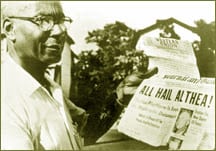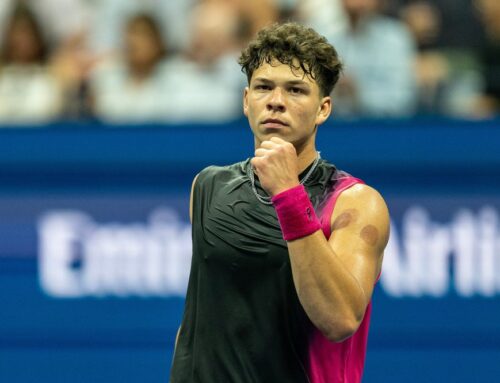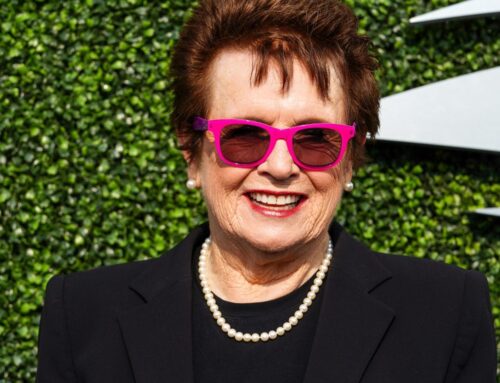
In September 1957, the lanky serve-and-volleyer, confirmed her greatness by becoming the first African American to capture the U.S. Nationals, which became the U.S. Open in 1968. That achievement, combined with her earlier Grand Slam singles titles at the 1956 French Open and Wimbledon (1957), helped change the face of tennis in America.
Her rise to stardom seems even more remarkable in retrospect because it’s the story of a trouble-seeking tomboy teen who wandered the streets of Harlem, New York before becoming one of the game’s most gifted and graceful women champions. She was guided and supported in her formative years primarily by two black physicians – Dr. Robert Walter Johnson of Lynchburg, Va., and Dr. Hubert Eaton Sr. of Wilmington, N.C. The physicians were members of the American Tennis Association, a predominantly black group formed in 1916 to afford blacks a chance to participate in tournament play in a social setting. Blacks at the time were barred from joining the whites only United States Lawn Tennis Association (USLTA), now known as the United States Tennis Association (USTA).
Gibson was groomed to be the first black to cross tennis’ color line, just as Jackie Robinson had pioneered the breakthrough in major league baseball in 1947. Indeed, Dr. Johnson borrowed a page from Branch Rickey’s turn-the-other-cheek philosophy to prepare Gibson and other black juniors for hostile reactions from whites determined to stymie racial integration.
“I knew being the first black champion, I would have to set an exemplary example for others who would follow,†said Gibson, who was 76 when she died Sept. 28, 2003. Following in her footsteps, the late Arthur Ashe, was grateful for her trailblazing tracks.
“Politically, Althea’s acceptance was crucial to my own,†Ashe said. “It made it easier for other blacks to follow.â€
Yet her hard road to glory didn’t resonate with the American public as Ashe’s did, nor did she receive any bankable degree of fame for her status as the game’s preeminent player in the late 1950s when tennis was an amateur sport.
Tennis became a lucrative career for players and a multimillion-dollar industry in 1968, the dawn of Ashe’s era but 10 years too late for Gibson, who retired after winning her second consecutive Wimbledon and U.S. Nationals crowns in 1958.
“I told her to do it again just to show the first time wasn’t a fluke,’’ said Sidney Llewellyn, Gibson’s coach.
A gifted athlete, who might have won several more Grand Slam titles, Gibson wanted to play longer, but the USLTA never offered financial assistance or helped her find a job.
“It was nice being the queen of tennis, but you can’t eat a crown,’’ Gibson often said.
Sharecroppers Daniel and Annie Gibson and their four children had their share of meal-less nights before leaving their Silver, S.C. home during the Great Depression for New York. Althea was three years old when Harlem’s streets became her playground. In her early teens, she quickly earned a reputation as her neighborhood’s most talented female athletes, excelling in baseball, basketball, football, stickball, paddle tennis and, of course, tennis. Her love of sports kept her on the right path, but occasional she had brushes with the law and seemed headed in the wrong direction. Former middleweight champion Sugar Ray Robinson and other Harlem celebrities provided guidance and kept her from going too far astray.
Her interest in tennis heightened considerably when she was 14 and took a lesson from Fred Johnson, a one-armed tennis coach, who was based at Harlem’s Cosmopolitan Tennis Club. A year later, Gibson won her first title, defeating Nina Irwin, a white girl, in the final of an ATA event. She soon became the ATA’s top female player, dominating the girls and most of the women’s divisions, and soon caught the eyes of Drs. Johnson and Eaton, who saw strokes of genius in her racket swing.
In 1946, Drs. Johnson and Eaton chatted quietly in the stands as they watched then-18-year-old Gibson lose to Roumania Peters 6-4, 7-9, 6-3 in the ATA Nationals women’s final played at Central State University in Wilberforce, Ohio.
Johnson whispered to Eaton, “You know, Hubert, I wish we could do something to help Althea. She’s a good player, but she’s not going to amount to much doing what she’s doing now, hanging on the streets of New York.â€
Eaton responded: “I tell you what, if her mother gives her permission, I’ll take her down to Wimbledon to live with my family and let her finish high school. You keep her during the summers and see to it that she gets to the tournaments.†Both physicians had tennis courts in their backyards.
Johnson agreed and Gibson was overjoyed. With her mother’s permission, Gibson headed South.
“Who wouldn’t be interested in a deal like that?†she said.
Gibson finished high school in Wilmington and later graduated from Florida A&M University. She stayed with Johnson each summer and played mostly ATA events. She won the ATA national singles title 10 consecutive years (1947-56). In the late 1940s, however, Gibson was never allowed to test her skills against the best white players in the U.S. Nationals. Despite her unblemished record and superb play, USLTA officials repeatedly denied her annual entry.
ATA officials, encouraged by Jackie Robinson’s integration of major league baseball, repeatedly but politely urged the USLTA to give Gibson an opportunity. Later, Johnson would use the same kill-‘em-with-kindness strategy that he taught Arthur Ashe and other black juniors who competed in USLTA junior events in the 1950s.
“I’ve seen too many (blacks) wreck their lives through hatred of whites,†said Johnson, who was a civil rights activist.
The ATA’s passive, dignified approach, combined with a tongue-lashing by Alice Marble, the USLTA’s top woman player of the 1930s, apparently changed enough USLTA minds to make a difference.
In a commentary published in the July 1950 issue of American Lawn Tennis magazine, Marble scolded the USLTA for using racial bigotry to bar Gibson from playing the U.S. Nationals.
“If tennis is a game for ladies and gentlemen, it’s also time we acted a little like gentle people and less like sanctimonious hypocrites,†Marble wrote. “I can’t think of any (white player) who would refuse to meet Miss Gibson in competition. She might be soundly beaten for awhile but she has a much better chance on the court than she does in the inner sanctum of the USLTA, where a different kind of game is played. If she is refused a chance to succeed or fail, then there is an un-eradicable mark against a game to which I have devoted most of my life and I would be bitterly ashamed.â€
Soon after Marble’s editorial was published, the USLTA opened its doors to Gibson. The Orange Lawn Tennis Association in South Orange, N.J. accepted her entry for the Eastern Grass Court Championships, as did the National Clay Court Championships in Chicago. A week before the 1950 U.S. Nationals and without fanfare, the USLTA announced that Gibson would be among the 49 women competing for the USLTA National women’s crown at the West Side Tennis Club in Forest Hills, NY.
For blacks in tennis Gibson’s acceptance at the U.S. Nationals was as special as Robinson’s first game as a Major League player. Indeed, a USTA panel recently ranked Gibson’s appearance at the 1950 U.S. Championships as the No. 1 moment in black tennis history. Gibson’s contributions, however, were not limited to the tennis court and were appreciated by people of every race. She was named Associated Press and Babe Zaharias Woman Athlete of the Year in 1957-58 and was honored with a New York ticker-tape parade after becoming the first black to win Wimbledon.
“We all know people who influence us and, if we are lucky, we meet a few in our lives who improve us,†said tennis legend Billie Jean King. “Althea Gibson improved my life and the lives of countless others. She was the first to break so many barriers and from the fist time I saw her play when I was 13 years old, she became, and remained, one of my true heroines.â€
Former pro and U.S. Fed Cup captain Zina Garrison, who attended Gibson’s camp as a junior, also considers her a heroine.
“She pushed me as if I were a pro, not a junior,’’ Garrison said. “She wouldn’t let me be a wimp when being a wimp was all I wanted to be.â€
Though Venus and Serena Williams never saw Gibson play, both said they were touched by her life. “It would be foolish to forget Althea,’’ Venus said.
After retiring on top of the tennis world, Gibson took advantage of her name to try other challenging careers. She recorded an album for Dot Records; got a bit part in Horse Soldiers, a 1959 John Wayne movie and spent a few years on the women’s professional golf tour. When she couldn’t find her niche pursing those careers, she worked for more than 15 years in public relations-type positions in New Jersey. She often was beset by financial woes.
Depressed and nearly broke after losing her job with the Governor’s Commission on Physical Fitness in the early 1990s, she had a stroke and lived as a recluse in her East Orange, N.J. home until she died. King, Garrison and former New York mayor David Dinkins were among a handful of people that she would allow to visit.
“It’s unfortunate that she never realized and reaped the rewards that she was due,’’ said Dinkens, a USTA board member.





Leave A Comment